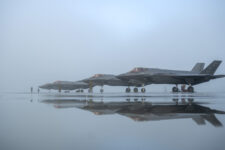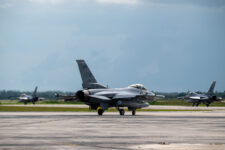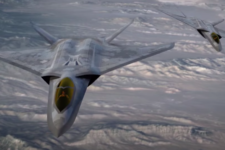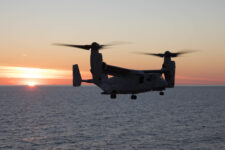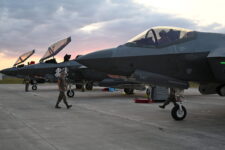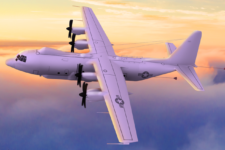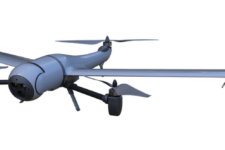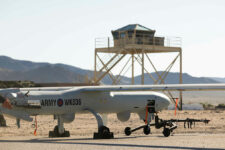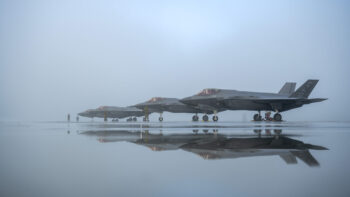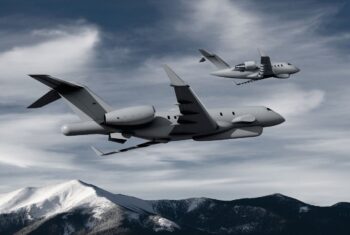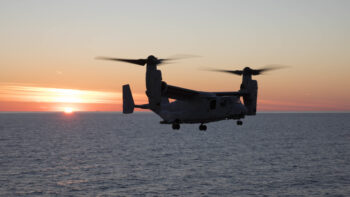
UVision’s Hero-120 loitering munition on display. (UVision)
JERUSALEM — After closing a new deal with American defense firm SAIC, Israel’s UVision has essentially doubled its production capacity to crank out Hero-120 loitering munitions as it moves to supply US special operations forces and potentially the larger Army, according to company executive Izthik Huber.
In an interview with Breaking Defense, Huber said the deal with SAIC, announced March 27, took eight months to negotiate and, the company said, will “significantly enhanc[e] rapid response capabilities” for customers of the UVisions’ US arm, UVisionUSA.
UVision, through UVisionUSA, already has facilities in the US, but the “landmark collaboration” with SAIC is “aimed at establishing a fully independent domestic supply chain,” UVision said in the March 27 announcement.
UVision focuses on loitering munitions that feature a cylindrical body with two sets of four cruciform wings that pop out in flight.
While the Hero-120 was the focus of the agreement with SAIC, Huber said it also allows for production of the Hero-30 and the larger Hero-400 as well. The Hero-120, at 30 pounds, can be carried by soldiers and can loiter over a target for more than an hour before striking, according to the company’s website. The Hero-30, a significantly smaller model at under nine pounds, can fly for about 40 minutes. The Hero-400 weighs over 100 pounds and can fly for more than two hours.
Breaking Defense reported back in 2019 that US special operations forces and Marines were interested in the tech, and Huber, vice-president for UVision in North America, said special ops forces already use the Hero-120 and the smaller Hero-30 models, and the company is in the “final step” of a program of record for US Special Operations Command. Huber said the company has “development programs” for the Hero-400 for the US Irregular Warfare Support Directorate. (SOCOM did not respond to Breaking Defense’s request for comment as of publication.)
“In addition to that we are in final process to get into certification for the US Army,” he said. “We did some successful demonstrations for US Army in last six months, including live fire and live drills and we will do some final steps in April.”
Huber, who served in the Israeli Air Force before his corporate career, said he hopes to see progress with the Army in the next months. Procurement by the Army outside of the special warfare groups would increase demand for the munitions.
“The scalability and rate of production could be much bigger numbers,” Huber said.
Further deals with the US military could also open up business to American allies and partners abroad, he said, especially as demand has skyrocketed in recent years.
The war in “Ukraine and what happened in Israel has put in the spotlight the use of unmanned systems. It used to be very expensive and sophisticated, but Ukraine showed if you have a bomb on an unmanned system, it can be efficient against the armed forces of Russia,” Huber noted.
Although the company does not disclose the cost-per-munition, loitering munitions are cheaper than cruise missiles and they have added capabilities over regular missiles.
“You need to find the target in advance with missiles, but with loitering munitions you can do recon [and] suppression, with one attack,” Huber said. “The price is lower than any missile. That opens a lot of markets in the world, including places that we wouldn’t think we would open like [integrating on] attack helicopters, ships, boats, UAVs.”
Huber also sees potential in loitering munitions fired from other UAVs — a relatively novel idea with which the Pentagon’s cutting edge research agency DARPA has toyed.
RELATED: DARPA’s aerial turducken, the LongShot, still cooking towards 2022 milestone
UVision hasn’t done it yet, “but there are RFP [request for proposals] talking about it, and that’s the future that will happen,” Huber said.
Pentagon awards Lockheed $11.8 billion undefinitized F-35 production contract
The Pentagon aims to finalize the contract for production lot 18 by the spring, though a similar award for lot 19 is not planned to follow until the fiscal 2025 budget is approved, according to the F-35 Joint Program Office.
